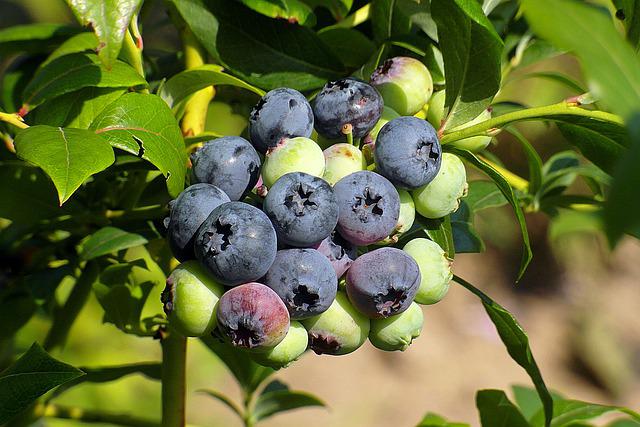When To Plant Blueberries?

All except the coldest regions can plant blueberries in the spring or late fall. If you live in Zone 5 or lower, you should wait until the middle of spring to grow. Except for green tissue culture plants, new plants will not be adversely affected by snow or occasional frost. There is no need to plant in the fall in the Northeast and Midwest because it is too cold.
Early spring and summer are ideal for purchasing and planting blueberry bushes from local garden centers. To get the best results in USDA zones 8 to 10, gardeners should start planting blueberry varieties like rabbiteye and highbush (V. corymbosum) early to midfall. UC Berkeley says that winter dormancy makes December and January ideal months to plant new blueberry plants. Gardeners in colder regions may have to wait until the ground thaws in the early spring before planting, and they may have to wait until the following year to see if their plantings bear fruit.
Early, mid-and late-season hybrids allow for a wider variety of berries to be harvested and a longer harvest period. So, for example, a row of early-season “Emerald” bushes with midseason “Blueray” and late-fruiting “Legacy” bushes will provide you with fruit all summer long. The blooming period for blueberries varies depending on the specific variety, but generally, blueberries bloom in late spring to early summer.
Table of Contents
Early-Season Blueberries
A lot of people like highbush blueberries because they can be eaten and used in cooking. Early-season highbush hybrids that grow in USDA zones 8 to 10 include “Earliblue,” which is a straight-growing plant that produces large, sweet fruits; “Rubel,” which has small, tangy berries; and “Spartan,” which has a lot of large berries. Many highbush hybrids are mixed with strains from the northeast, like “Northcountry,” which is one of them. Sweet, light-blue berries come out of this plant early in the season. It grows less than 3 feet tall.
Mid- and Late-Season Blueberries
Blueberries are in season during the middle and the end of the year. This group of plants is called a highbush blueberry, and it grows up to 4 feet tall. “Olympia,” which has medium-sized fruits, and “Berkeley,” which has large, light blueberries, are the other two. Fruits made by late-season highbush hybrids like “Elliot” are sweet and tangy. They come in different sizes.

Fall Planting
Blueberries can be planted in the fall, but most experts recommend planting in late winter or early spring. Planting blueberries in the fall should be done in late September or early October. These bushes’ roots will continue to grow until soil temperatures fall below 45°F.
It’s good to plant blueberries in the fall because your blueberries will be ready to grow when the rains come in the spring. Planting blueberries in the fall is already done, so they can enjoy a burst of growth that can make a big difference this year.
Blueberry plants need to be in the ground and mulched before the first frost, especially in areas with a lot of snow.
Spring Planting
Your blueberry bushes should be planted in the spring to start growing in the same way that plants do in nature. There is no longer any risk of a freeze. Planting blueberries at this time will give them the best chance of growing before the winter, but be aware that planting in the spring can be pushed back by rain. Time is important. Plant as soon as the risk of frost is over. In different parts of the country, this varies.
Choosing and Preparing a Place to Plant
- Choose a spot that is both sunny and safe. While blueberries can grow in the shade, the best crops are in the sun. At the same time, they should not be exposed to rough wind, which dries them.
- You don’t want to plant blueberries close to trees because the trees will block out the sun and eat up any moisture in the soil.
- As a rule, it’s better to plant multiple bushes together in a single area of your garden than spread them out all over the place. This will help grow more berries and improve their quality.
- Plants like blueberry have shallow roots. For this reason, it needs soil that can hold a lot of water but also drains well and doesn’t stay wet for long. You shouldn’t plant blueberries because they have heavy, clayey soils that stay wet.
- Blueberries like acidic soil, and they grow best in that type of soil. Soil that isn’t acidic enough will slow down plant growth. It can be easier to make the soil more acidic by adding a small amount of granulated sulfur to the soil several months before planting. People who want to make their soil more acidic can add peat moss and pine bark or needles.
- You should add organic matter to the soil before you plant your blueberry bushes, so they grow well. You can learn more about soil amendments and how to make the soil ready to plant.
Care and Planting
- Avoid planting them on the ground. At this point, the rootball should be barely visible (one-quarter to one-half inch).
- Dig 20-inch-deep and 18-inch-wide holes in the ground (or about twice as wide and twice as deep as the plant’s roots).
- Rows of bushes should be spaced at least 8 feet apart. Using two parts loam to one part oak leaf mold, peat, aged sawdust, or compost for the planting mix, fill the hole to the brim with this material.
- To ensure that the bush’s roots are fully exposed, place it in the hole with the rootball at or just below ground level. Compaction is key when filling in the void.
- One month after planting, rather than at the time of planting, apply fertilizer. A band around the plant 6-12 inches from the crown and apply 12 ounces of 10-10-10 fertilizer.
